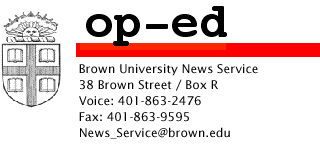Distributed March 24, 2003
Copyright ©2003 by Brent Stuart Goodwin
Op-Ed Editor: Mark Nickel
About 540 Words
Brent Stuart Goodwin
The Shock and Awe approach to war: Target the means and will to fight
War is an unfortunate feature of this world. As long as there are wars, the humane thing to do is to seek to make them as quick and decisive as possible, which goes a long way toward preventing them in the first place.
Some months after leaving a cubicle in the U.S. Department of State’s Office of International Security and Peacekeeping in 1996, I received a copy of Shock and Awe: Achieving Rapid Dominance by Harlan Ullman et al. (National Defense University: 1996). I was initially most impressed with its theoretical prioritization of strategy over technology. Many post-Gulf War analyses tended toward hagiography of the role of technology in international affairs. Now I find myself thinking about the humanity of Shock and Awe’s central tenet: quick, decisive and stable conclusion to war – and, if possible, dissuading adversaries from war altogether.
Shock and Awe is the means to what is known as rapid dominance. Rapid dominance aims at more than merely destroying an adversary’s military capability, although that remains an acceptable goal. It aims at destroying the adversary’s will, perception and understanding so that the adversary’s military capability is worthless. Shock and Awe contributes to rapid dominance by convincing the adversary that resistance is futile before, during and after battle. Shock and Awe achieves this through rapid simultaneous attacks from land, sea, air, special operations and space, which stun and produce immediate paralysis. The adversary’s ability to absorb information and damage is overwhelmed by discriminate and precise elimination of targets.
Shock and Awe paralyzes by disrupting the adversary’s decision-making process. In the formulation first posited by Air Force theorist John Boyd, participants in a conflict observe, orient, decide upon action, then act (OODA); the participant with the faster “OODA loop” – i.e., the one able to go from observation to action most rapidly – is able to shape the operating environment and control the situation. Of the four stages, orientation is the key; Shock and Awe prevents or delays the transition from observation to orientation. Shock and Awe paralyzes the adversary from the very first observation. The result is that many battles that could take place will never happen, and those that do are initially intense but of shorter duration. Shock and Awe intends not only to take away the means of waging war but to blunt the will to wage war.
The authors of Shock and Awe are explicit in limiting the scope of application of Shock and Awe. It is to be applied only to blatant international aggression, rogue states with weapons of mass destruction, large-scale human rights abuses and threats to vital world markets.
The intellectual roots of this doctrine are the writings of Karl von Clausewitz (shock), and the much earlier writings of Sun Tzu (awe). However the doctrine also owes much to experience gained in the opening stages of Operation Just Cause in Panama, and Operation Desert Shield/Storm in Kuwait. Policy champions include Secretary of State Colin Powell, a one-time student of Ullman at the National Defense University in Washington, D.C., and Secretary of Defense Donald Rumsfeld. In theory, the Shock and Awe approach to war requires fewer forces for a shorter period of time and may produce a demonstration effect that dissuades present and future adversaries.
War is an unfortunate feature of this world. As long as there are wars, the humane thing to do is to seek to make them as quick and decisive as possible, which goes a long way toward preventing them in the first place.





